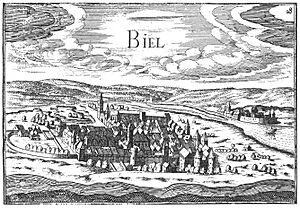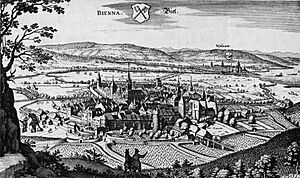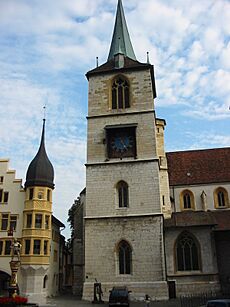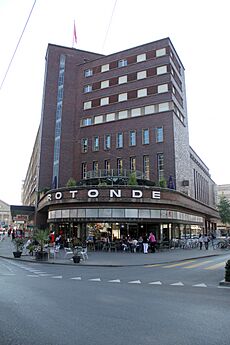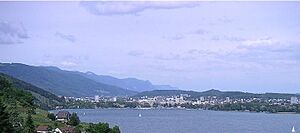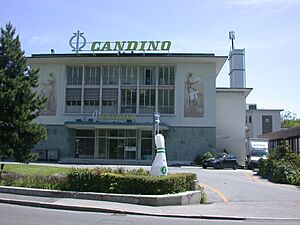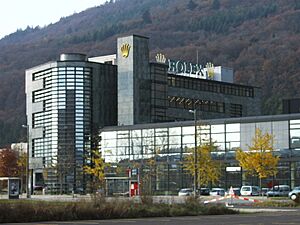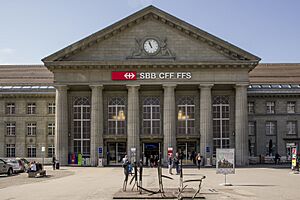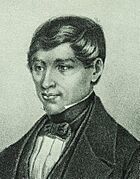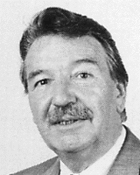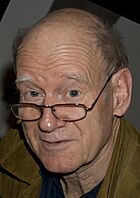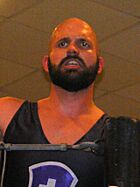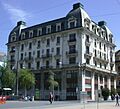Biel/Bienne facts for kids
Quick facts for kids
Biel/Bienne
|
||
|---|---|---|
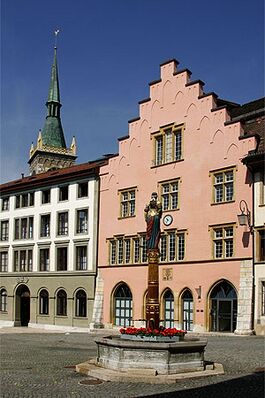
City Hall in the Old Town of Biel/Bienne
|
||
|
||
| Country | Switzerland | |
| Canton | Bern | |
| District | Biel/Bienne | |
| Area | ||
| • Total | 21.19 km2 (8.18 sq mi) | |
| Elevation
(Railway station)
|
437 m (1,434 ft) | |
| Population
(Dec 2020 )
|
||
| • Total | 55,206 | |
| • Density | 2,605.3/km2 (6,747.7/sq mi) | |
| Demonym(s) | German: Bieler/in, French: Biennois(e) | |
| Postal code |
2500–2510
|
|
| Surrounded by | Brügg, Ipsach, Leubringen/Magglingen (Evilard/Macolin), Nidau, Orpund, Orvin, Pieterlen, Port, Safnern, Tüscherz-Alfermée, Vauffelin | |
| Twin towns | Iserlohn (Germany) | |
Biel/Bienne is a special city in Switzerland. It is located in the canton of Bern. What makes it unique is that it is a bilingual city. This means both German and French are spoken here. In fact, its official name uses both languages: Biel (German) and Bienne (French).
With over 55,000 people living there, Biel/Bienne is one of Switzerland's largest cities. It has been a major industrial center since the 1800s. It is especially famous for making watches. Many world-famous watch brands like Rolex, Omega, and Swatch have their homes here. Because of this, some people call it the "world capital of watchmaking."
The city sits at the bottom of the Jura Mountains. It is also on the northeastern shore of Lake Biel. Nearby cities like Neuchâtel, Solothurn, and Bern (the capital of Switzerland) are only about 30 minutes away by train or car. Larger cities like Zurich, Basel, and Lausanne are about an hour away.
Contents
Exploring Biel/Bienne's Past
Early Settlements by the Lake
People have lived by Lake Biel for a very long time. Scientists have found traces of ancient villages from the Stone Age. These villages were built on stilts over the water. One of these sites, Vingelz / Hafen, is now a UNESCO World Heritage Site.
Later, during the Roman Empire, a Roman road passed through the area. Foundations of Roman buildings have been found. Some people think the city's name, Biel, comes from an old god named Belenus. Others believe it comes from an old word for "axe," which is why two crossed axes are on the city's coat of arms.
How the City Began
In the 1200s, the Bishop of Basel likely founded the town. A castle, Biel Castle, was built around this time. Biel was officially under the Bishop's rule for many centuries. But the city council often tried to gain more freedom.
In 1275, the King of Germany, Rudolph of Habsburg, gave Biel its own town charter. This was like a special rulebook for the city. The city's main church, St. Benedict's, was built in the 1400s. It is a beautiful example of late-Gothic architecture.
Joining the Swiss Confederation
Over time, Biel started making friends with nearby cities. It allied with Bern in 1279. Even though it was still officially part of the Bishop's lands, Biel became close to the Old Swiss Confederacy. After helping in the Burgundy Wars, Biel was recognized as a full member by 1494.
In 1528, Biel changed its religion to Protestantism. This happened even though the Catholic Bishops of Basel still had some control.
From French Rule to Modern Times
The French Revolution brought big changes to Biel/Bienne. In 1798, French troops marched into the city. Biel became part of France for a short time. After the French Empire fell, Biel joined the canton of Bern in 1815.
In the early 1900s, workers in Biel/Bienne started to demand better conditions. There were big strikes, like the carpenters' strike in 1907. In the 1930s, the city made many changes to help its citizens. The Volkshaus (People's House) was built during this time. It is a famous building that shows the city's focus on social planning.
In 1978, when the new canton of Jura was formed, Biel was asked to become its capital. But the city decided to stay with the canton of Bern.
The city's population grew a lot in the 1900s. It reached its highest point in the 1960s with about 65,000 people. Today, it is just over 50,000.
Biel/Bienne's Landscape and Weather
City Layout and Surroundings
Biel/Bienne is located at the foot of the Jura Mountains. It sits on the northeast end of Lake Biel. The city includes several smaller villages that joined over time, like Vingelz and Bözingen.
The city is made up of different types of land. About 45% is covered by forests. Another 45% is used for buildings and roads. A small part is for farming, and some is rivers or lakes.
What's the Weather Like?
Biel/Bienne has a moderate climate. Summers are generally warm, and winters are cool. It gets a good amount of rain throughout the year. Snowfall is common in winter, especially in January and December. The city can sometimes be covered by low clouds, but if you go up the mountain, you might find sunshine!
Who Lives in Biel/Bienne?
Population Facts
Biel/Bienne is home to over 50,000 people. About 28% of the people living here are from other countries. Many people who live in Biel/Bienne were also born there. Others come from different parts of Switzerland or from outside the country.
The city has a mix of ages. About 19% of the population are children and teenagers (under 19). Most people, about 62%, are adults (20-64 years old). About 19% are seniors (over 64).
Languages Spoken
Biel/Bienne is famous for being bilingual. Most people speak German as their first language (about 55%). The second most common language is French (about 28%). You will also hear Italian and other languages.
Because it is bilingual, Biel/Bienne is sometimes called the "Swiss City of Communication." Many companies that need people who speak both German and French choose to set up their offices here.
Religions in the City
Biel/Bienne has many different religions. The largest groups are Protestants and Roman Catholics. There are also people who belong to Orthodox churches, other Christian churches, and those who are Muslim or Jewish. Some people are Buddhist or Hindu. Many people in Biel/Bienne do not belong to any church.
Things to See and Do
Biel/Bienne is a great place to visit. It is close to other famous watchmaking towns that are also UNESCO World Heritage Sites. You can visit many watch factories here. The Swatch Group, a huge watch company, has its main office in Biel/Bienne.
The old part of the city is very charming. It has a beautiful Gothic church from the 1400s. You can also see old guild halls and fountains. Outside the old town, there are museums like the Neuhaus and Schwab Museums.
The Jura Mountains are just north of the city. You can take two funicular railways (like small trains that go up steep hills) to reach the higher areas. The Biel–Magglingen Funicular takes you to Magglingen/Macolin, a national sports center. The Bienne–Evilard Funicular goes to the city hospital and a nearby village. The Taubenloch gorge, a steep canyon, is also a popular spot.
Lake Biel is west of the city. You can enjoy the parks along the lake or take a boat trip. The city's harbor is a starting point for tours on Lake Biel, Neuchâtel, and Murten/Morat. These three lakes are connected by canals, so you can travel between them by boat.
Important Historic Places
Many buildings and places in Biel/Bienne are considered important national heritage sites. These include the old City Hall, the main train station, and several historic houses and churches. The entire town of Biel/Bienne and the Taubenlochschlucht canyon are also protected as important Swiss heritage sites.
A World Heritage Site
Biel/Bienne is home to the Vingelz / Hafen archaeological site. This site has remains of ancient pile-dwelling villages. These villages were built on stilts in the lake thousands of years ago. They are part of the Prehistoric Pile dwellings around the Alps UNESCO World Heritage Site. Scientists have found old tools, textiles, and even axe handles from these ancient settlements.
Business and Jobs in Biel/Bienne
Biel/Bienne is a hub for companies that make special machines and precise tools. It is especially known for its watch industry.
- Rolex makes watch parts here.
- Swatch Group has headquarters for brands like Omega SA and Swatch in the city.
- The main office for the Federation of the Swiss Watch Industry FH is also located here.
Many people in Biel/Bienne work in manufacturing, especially in the watch industry. Others work in sales, transportation, hotels, or healthcare. The city is a place where many people come to work from other towns.
Learning in Biel/Bienne
Education is important in Biel/Bienne. Many people have finished high school or gone on to higher education like university.
The school system in the Canton of Bern starts with one year of kindergarten. Then, students go to six years of primary school. After that, they have three years of secondary school. Students can then choose to continue their studies or start an apprenticeship to learn a trade.
Biel/Bienne has several libraries. These libraries have many books and other media for students and residents to use.
Culture and Fun
Biel/Bienne has its own newspapers, some of which are bilingual. The city is also home to the Theater Biel Solothurn, where you can watch plays.
Every year, Biel hosts an International Chess Festival. Chess players from all over the world come to compete. The city also hosts a famous 100 km Ultramarathon race every June. This is a very long running race!
In 2004, Biel/Bienne won the Wakker Prize. This award is given to Swiss towns that do a great job of preserving their heritage and developing their city.
Getting Around Biel/Bienne
Biel/Bienne has excellent public transport. Buses and trains connect the city to its surrounding areas and to other parts of Switzerland. The Biel/Bienne railway station is a very busy train station. It connects the city to major Swiss cities like Geneva, Bern, Basel, Zurich, and Lausanne.
As mentioned before, two funicular railways take you up the mountains above the city. The port on Lake Biel is a great place to start boat trips. You can explore the three connected lakes: Biel, Neuchâtel, and Murten.
The city is also well-connected by highways to other Swiss cities. You can reach major international airports in Geneva, Basel, and Zurich in about 1.5 hours by direct train.
Sports in Biel/Bienne
Biel/Bienne is home to popular sports teams:
- EHC Biel: A professional ice hockey team.
- FC Biel-Bienne: A football (soccer) club.
Famous People from Biel/Bienne
Many interesting people have lived in or come from Biel/Bienne.
- Nicolas Hayek (1928–2010): A businessman who helped create The Swatch Group. He was made an honorary citizen of Biel/Bienne.
- Thomas Wyttenbach (c. 1472–1526): An important figure during the Protestant Reformation in Biel.
- Robert Walser (1878–1956): A famous Swiss writer.
- Maurice Edmond Müller (1918–2009): An orthopedic surgeon who developed new ways to fix broken bones.
- René Felber (1933–2020): A Swiss politician who was a member of the Swiss Federal Council.
- Franz Hohler (born 1943): A well-known author and cabaret artist.
- Thomas Jordan (born 1963): The chairman of the Swiss National Bank.
- Nemo Mettler (born 1999): A singer and rapper who won the Eurovision Song Contest 2024 for Switzerland!
The city has also produced many talented athletes, including:
- Étienne Dagon (born 1960): An Olympic bronze medalist in swimming.
- Marcel Fischer (born 1978): An Olympic gold medalist in fencing.
- Ares (Marco Jaggi) (born 1980): A professional wrestler.
- Martina Kocher (born 1985): A luger who competed in the Winter Olympics.
Images for kids
See Also
 In Spanish: Biena para niños
In Spanish: Biena para niños






